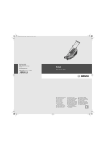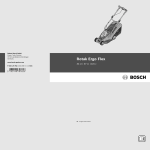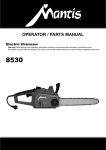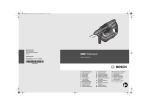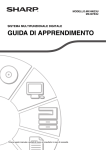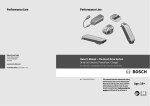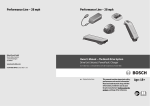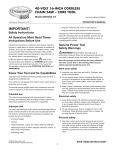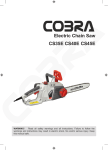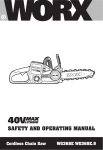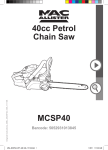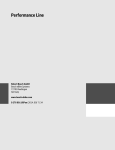Download Bosch AKE 30 LI Instruction manual
Transcript
OBJ_DOKU-18901-003.fm Page 1 Tuesday, October 4, 2011 9:34 AM Robert Bosch GmbH Power Tools Division 70745 Leinfelden-Echterdingen Germany AKE 30 LI www.bosch-garden.com F 016 L70 758 (2011.10) O / 376 UNI de en fr es pt it nl Originalbetriebsanleitung Original instructions Notice originale Manual original Manual original Istruzioni originali Oorspronkelijke gebruiksaanwijzing da Original brugsanvisning sv Bruksanvisning i original no Original driftsinstruks fi Alkuperäiset ohjeet el tr pl cs sk hu ru Πρωτότυπο οδηγιών χρήσης Orijinal işletme talimat Instrukcja oryginalna Původní návod k používání Pôvodný návod na použitie Eredeti használati utasítás Оригинальное руководство по эксплуатации uk Оригінальна інструкція з експлуатації ro Instrucţiuni originale bg Оригинална инструкция sr sl hr et lv lt Originalno uputstvo za rad Izvirna navodila Originalne upute za rad Algupärane kasutusjuhend Instrukcijas oriģinālvalodā Originali instrukcija OBJ_BUCH-1275-003.book Page 2 Tuesday, October 4, 2011 9:21 AM 2| Deutsch . . . . . . . . . . . . . . . . . . . . . Seite English . . . . . . . . . . . . . . . . . . . . . . . Page Français . . . . . . . . . . . . . . . . . . . . . . Page Español . . . . . . . . . . . . . . . . . . . . Página Português. . . . . . . . . . . . . . . . . . . Página Italiano . . . . . . . . . . . . . . . . . . . . . Pagina Nederlands. . . . . . . . . . . . . . . . . . Pagina Dansk . . . . . . . . . . . . . . . . . . . . . . . . Side Svenska . . . . . . . . . . . . . . . . . . . . . . Sida Norsk . . . . . . . . . . . . . . . . . . . . . . . . Side Suomi. . . . . . . . . . . . . . . . . . . . . . . . Sivu Ελληνικά. . . . . . . . . . . . . . . . . . . . . Σελίδα Türkçe . . . . . . . . . . . . . . . . . . . . . . Sayfa Polski . . . . . . . . . . . . . . . . . . . . . . Strona 1 6 20 33 47 62 76 91 105 117 129 141 153 168 181 Česky . . . . . . . . . . . . . . . . . . . . . . Strana 196 Slovensky. . . . . . . . . . . . . . . . . . . Strana 208 Magyar . . . . . . . . . . . . . . . . . . . . . . Oldal 222 Русский . . . . . . . . . . . . . . . . . . Страница 237 Українська. . . . . . . . . . . . . . . . Сторінка 253 Română . . . . . . . . . . . . . . . . . . . . Pagina 268 Български . . . . . . . . . . . . . . . . Страница 282 Srpski . . . . . . . . . . . . . . . . . . . . . Strana 298 Slovensko . . . . . . . . . . . . . . . . . . . Stran 311 Hrvatski . . . . . . . . . . . . . . . . . . . Stranica 324 Eesti. . . . . . . . . . . . . . . . . . . . . Lehekülg 337 Latviešu . . . . . . . . . . . . . . . . . . . Lappuse 349 Lietuviškai . . . . . . . . . . . . . . . . . Puslapis 363 2 3 5 6 4 18 17 7 8 16 9 Part Number XXXXXXXXXX Serial Number XXXXXXXXX 20XX 15 14 13 12 11 10 AKE 30 LI 2 607 336 005 (4,5 Ah) 2 607 336 107 (2,6 Ah) A B 20 18 17 19 17 21 22 23 24 22 23 25 18 17 26 24 F 016 L70 758 | (4.10.11) 25 Bosch Power Tools OBJ_BUCH-1275-003.book Page 3 Tuesday, October 4, 2011 9:21 AM |3 C1 27 11 10 28 29 30 31 33 30 32 C2 13 30 30 C3 12 D 15 12 15 10 11 5– 10 mm E 7 4 2 3 34 Bosch Power Tools F 016 L70 758 | (4.10.11) OBJ_BUCH-1275-003.book Page 4 Tuesday, October 4, 2011 9:21 AM 4| F 6 8 8 G H 8 X I J Y Z Z Y K 50 mm X Y Z W 50 mm F 016 L70 758 | (4.10.11) Bosch Power Tools OBJ_BUCH-1275-003.book Page 5 Tuesday, October 4, 2011 9:21 AM |5 L M N 1 1/3 2 2/3 O P 1 2 2/3 1/3 Bosch Power Tools F 016 L70 758 | (4.10.11) OBJ_BUCH-1275-003.book Page 20 Tuesday, October 4, 2011 9:21 AM 20 | English Safety Notes en Explanation of symbols Read instruction manual. f Do not abuse the cord. Never use the cord for carrying, pulling or unplugging the power tool. Keep cord away from heat, oil, sharp edges and moving parts. Damaged or entangled cords increase the risk of electric shock. Do not use the machine in the rain or leave it outdoors when it is raining. f When operating a power tool outdoors, use an extension cord suitable for outdoor use. Use of a cord suitable for outdoor use reduces the risk of electric shock. Remove battery before adjusting or cleaning, and before leaving the machine unattended for any period. f If operating a power tool in a damp location is unavoidable, use a residual current device (RCD) protected supply. Use of an RCD reduces the risk of electric shock. Wear safety goggles. Wear ear protection. Remove the plug from the socket or mains immediately before carrying out any adjustments, servicing or maintenance or if the cable is damaged or cut. The kickback brake and the run-down brake stop the chain saw within short time. General Power Tool Safety Warnings WARNING Read all safety warnings and all instructions. Failure to follow the warnings and instructions may result in electric shock, fire and/or serious injury. Save all warnings and instructions for future reference. The term “power tool” in the warnings refers to your mains-operated (corded) power tool or battery-operated (cordless) power tool. Personal safety f Stay alert, watch what you are doing and use common sense when operating a power tool. Do not use a power tool while you are tired or under the influence of drugs, alcohol or medication. A moment of inattention while operating power tools may result in serious personal injury. f Use personal protective equipment. Always wear eye protection. Protective equipment such as dust mask, non-skid safety shoes, hard hat, or hearing protection used for appropriate conditions will reduce personal injuries. f Prevent unintentional starting. Ensure the switch is in the off-position before connecting to power source and/or battery pack, picking up or carrying the tool. Carrying power tools with your finger on the switch or energising power tools that have the switch on invites accidents. f Remove any adjusting key or wrench before turning the power tool on. A wrench or a key left attached to a rotating part of the power tool may result in personal injury. f Keep work area clean and well lit. Cluttered or dark areas invite accidents. f Do not overreach. Keep proper footing and balance at all times. This enables better control of the power tool in unexpected situations. f Do not operate power tools in explosive atmospheres, such as in the presence of flammable liquids, gases or dust. Power tools create sparks which may ignite the dust or fumes. f Dress properly. Do not wear loose clothing or jewellery. Keep your hair, clothing and gloves away from moving parts. Loose clothes, jewellery or long hair can be caught in moving parts. f Keep children and bystanders away while operating a power tool. Distractions can cause you to lose control. f If devices are provided for the connection of dust extraction and collection facilities, ensure these are connected and properly used. Use of dust collection can reduce dust-related hazards. Work area safety Electrical safety f Power tool plugs must match the outlet. Never modify the plug in any way. Do not use any adapter plugs with earthed (grounded) power tools. Unmodified plugs and matching outlets will reduce risk of electric shock. f Avoid body contact with earthed or grounded surfaces, such as pipes, radiators, ranges and refrigerators. There is an increased risk of electric shock if your body is earthed or grounded. Power tool use and care f Do not force the power tool. Use the correct power tool for your application. The correct power tool will do the job better and safer at the rate for which it was designed. f Do not use the power tool if the switch does not turn it on and off. Any power tool that cannot be controlled with the switch is dangerous and must be repaired. f Do not expose power tools to rain or wet conditions. Water entering a power tool will increase the risk of electric shock. F 016 L70 758 | (4.10.11) Bosch Power Tools OBJ_BUCH-1275-003.book Page 21 Tuesday, October 4, 2011 9:21 AM English | 21 f Disconnect the plug from the power source and/or the battery pack from the power tool before making any adjustments, changing accessories, or storing power tools. Such preventive safety measures reduce the risk of starting the power tool accidentally. f Store idle power tools out of the reach of children and do not allow persons unfamiliar with the power tool or these instructions to operate the power tool. Power tools are dangerous in the hands of untrained users. f Maintain power tools. Check for misalignment or binding of moving parts, breakage of parts and any other condition that may affect the power tool’s operation. If damaged, have the power tool repaired before use. Many accidents are caused by poorly maintained power tools. f Keep cutting tools sharp and clean. Properly maintained cutting tools with sharp cutting edges are less likely to bind and are easier to control. f Use the power tool, accessories and tool bits etc. in accordance with these instructions, taking into account the working conditions and the work to be performed. Use of the power tool for operations different from those intended could result in a hazardous situation. Battery tool use and care f Recharge only with the charger specified by the manufacturer. A charger that is suitable for one type of battery pack may create a risk of fire when used with another battery pack. f Use power tools only with specifically designated battery packs. Use of any other battery packs may create a risk of injury and fire. f When battery pack is not in use, keep it away from other metal objects, like paper clips, coins, keys, nails, screws or other small metal objects, that can make a connection from one terminal to another. Shorting the battery terminals together may cause burns or a fire. f Under abusive conditions, liquid may be ejected from the battery; avoid contact. If contact accidentally occurs, flush with water. If liquid contacts eyes, additionally seek medical help. Liquid ejected from the battery may cause irritation or burns. Service f Have your power tool serviced by a qualified repair person using only identical replacement parts. This will ensure that the safety of the power tool is maintained. Chain Saw Safety Warnings f Keep all parts of the body away from the saw chain when the motor is operating. Before you start the chain saw, make sure the saw chain is not contacting anything. A moment of inattention while operating chain saws may cause entanglement of your clothing or body with the saw chain. Bosch Power Tools f Always hold the chain saw with your right hand on the rear handle and your left hand on the front handle. Holding the chain saw with a reversed hand configuration increases the risk of personal injury and should never be done. f Hold the power tool by insulated gripping surfaces only, because the saw chain may contact hidden wiring. Saw chains contacting a “live” wire may make exposed metal parts of the power tool “live” and could give the operator an electric shock. f Wear safety glasses and hearing protection. Further protective equipment for head, hands, legs and feet is recommended. Adequate protective clothing will reduce personal injury by flying debris or accidental contact with the saw chain. f Do not operate a chain saw in a tree. Operation of a chain saw while up in a tree may result in personal injury. f Always keep proper footing and operate the chain saw only when standing on fixed, secure and level surface. Slippery or unstable surfaces such as ladders may cause a loss of balance or control of the chain saw. f When cutting a limb that is under tension be alert for spring back. When the tension in the wood fibres is released the spring loaded limb may strike the operator and/or throw the chain saw out of control. f Use extreme caution when cutting brush and saplings. The slender material may catch the saw chain and be whipped toward you or pull you off balance. f Carry the chain saw by the front handle with the chain saw switched off and away from your body. When transporting or storing the chain saw, always fit the guide bar cover. Proper handling of the chain saw will reduce the likelihood of accidental contact with the moving saw chain. f Follow instructions for lubricating, chain tensioning and changing accessories. Improperly tensioned or lubricated chain may either break or increase the chance for kickback. f Keep handles dry, clean, and free from oil and grease. Greasy, oily handles are slippery causing loss of control. f Cut wood only. Don’t use chain saw for purposes not intended. For example: do not use chain saw for cutting plastic, masonry or non-wood building materials. Use of the chain saw for operations different than intended could result in a hazardous situation. Causes and operator prevention of kickback: – Kickback may occur when the nose or tip of the guide bar touches an object, or when the wood closes in and pinches the saw chain in the cut. – Tip contact in some cases may cause a sudden reverse reaction, kicking the guide bar up and back towards the operator. – Pinching the saw chain along the top of the guide bar may push the guide bar rapidly back towards the operator. – Either of these reactions may cause you to lose control of the saw which could result in serious personal injury. Do not rely exclusively F 016 L70 758 | (4.10.11) OBJ_BUCH-1275-003.book Page 22 Tuesday, October 4, 2011 9:21 AM 22 | English upon the safety devices built into your saw. As a chain saw user, you should take several steps to keep your cutting jobs free from accident or injury. Kickback is the result of tool misuse and/or incorrect operating procedures or conditions and can be avoided by taking proper precautions as given below: f Maintain a firm grip, with thumbs and fingers encircling the chain saw handles, with both hands on the saw and position your body and arm to allow you to resist kickback forces. Kickback forces can be controlled by the operator, if proper precautions are taken. Do not let go of the chain saw. f Do not overreach and do not cut above shoulder height. This helps prevent unintended tip contact and enables better control of the chain saw in unexpected situations. f Only use replacement bars and chains specified by the manufacturer. Incorrect replacement bars and chains may cause chain breakage and/or kickback. f Follow the manufacturer’s sharpening and maintenance instructions for the saw chain. Decreasing the depth gauge height can lead to increased kickback. Additional safety warnings f It is recommended that the first time user should have practical instruction in the use of the chainsaw and the protective equipment from an experienced operator. The initial practice should be cutting logs on a saw horse or cradle. f This tool is not intended for use by persons (including children) with reduced physical, sensory or mental capabilities, or lack of experience and knowledge, unless they have been given supervision or instruction concerning use of the appliance by a person responsible for their safety. Children should be supervised to ensure that they do not play with the appliance. f Children and juveniles, with the exception of apprentices older than 16 years and under supervision, may not operate the chain saw. The same applies for persons who do not or do not sufficiently know how to handle the chain saw. The operating instructions should always be ready to hand. Persons unfit or tired must not operate the chain saw. f When working with the machine, always hold it firmly with both hands and provide for a secure stance. The power tool is guided more secure with both hands. f Always ensure all handles and guards are fitted when using the machine. Never attempt to use an incomplete machine or one fitted with an unauthorized modification. f Wait until the machine has come to a standstill before placing it down. f Do not open the battery. Danger of shortcircuiting. Protect the battery against heat, e. g., against continuous intense sunlight, fire, water, and moisture. Danger of explosion. F 016 L70 758 | (4.10.11) f In case of damage and improper use of the battery, vapours may be emitted. Provide for fresh air and seek medical help in case of complaints. The vapours can irritate the respiratory system. f When the battery is defective, liquid can escape and come into contact with adjacent components. Check any parts concerned. Clean such parts or replace them, if required. f Use the battery only in conjunction with your Bosch power tool. This measure alone protects the battery against dangerous overload. f Use only original Bosch batteries with the voltage listed on the nameplate of your power tool. When using other batteries, e. g. imitations, reconditioned batteries or other brands, there is danger of injury as well as property damage through exploding batteries. Safety Warnings for battery chargers Keep the battery charger away from rain or moisture. Penetration of water in the battery charger increases the risk of an electric shock. f Only charge Bosch lithium ion batteries or batteries installed in Bosch products with the voltages listed in the technical data. Otherwise there is danger of fire and explosion. f Keep the battery charger clean. Contamination can lead to danger of an electric shock. f Before each use, check the battery charger, cable and plug. If damage is detected, do not use the battery charger. Never open the battery charger yourself. Have repairs performed only by a qualified technician and only using original spare parts. Damaged battery chargers, cables and plugs increase the risk of an electric shock. f Do not operate the battery charger on easily inflammable surfaces (e. g., paper, textiles, etc.) or surroundings. The heating of the battery charger during the charging process can pose a fire hazard. f Supervise children. This will ensure that children do not play with the charger. f Children or persons that owing to their physical, sensory or mental limitations or to their lack of experience or knowledge, are not capable of securely operating the charger, may only use this charger under supervision or after having been instructed by a responsible person. Otherwise, there is danger of operating errors and injuries. Products sold in GB only: Your product is fitted with an BS 1363/A approved electric plug with internal fuse (ASTA approved to BS 1362). If the plug is not suitable for your socket outlets, it should be cut off and an appropriate plug fitted in its place by an authorised customer service agent. The replacement plug should have the same fuse rating as the original plug. The severed plug must be disposed of to avoid a possible shock hazard and should never be inserted into a mains socket elsewhere. Bosch Power Tools OBJ_BUCH-1275-003.book Page 23 Tuesday, October 4, 2011 9:21 AM English | 23 Product Description and Specifications Read all safety warnings and all instructions. Failure to follow the warnings and instructions may result in electric shock, fire and/or serious injury. Intended Use 4 Oil filler cap 5 Front handle 6 Activation lever for kickback brake (hand guard) 7 Oil level gauge 8 Gripping teeth 9 Chain guard 10 Chain bar 11 Saw chain The power tool is intended for sawing wood such as wooden beams, planks, branches, tree trunks, etc., and for sawing of trees. Cuts can be sawed with or across the grain. 12 Locking knob This power tool is not suitable for sawing mineral materials. 16 Serial number Delivery Scope Carefully remove the power tool from its packaging and check if the following parts are complete: – – – – – – – Chain saw Cover Chain Chain bar Chain guard Oil Sachet Operating instructions Battery and charger are included in certain executions. When parts are missing or damaged, please contact your dealer. 13 Cover 14 Ventilation slots – outlet 15 Chain tensioning knob 17 Battery 18 Battery unlocking button 19 Button for charge-control indicator 20 Battery charge-control indicator 21 Temperature control indicator 22 Charging compartment 23 Battery charger 24 Red LED indicator on the battery charger 25 Green LED indicator on the battery charger 26 Power plug ** 27 Symbol for rotation and cutting direction 28 Drive sprocket 29 Fastening bolt 30 Chain tensioning peg 31 Oil outlet 32 Guide fin for chain bar Product Features 33 Chain catch bolt The numbering of the product features refers to the illustration of the machine on the graphics page. 34 Ventilation slots – inlet 1 Rear handle 2 Lock-off button for On/Off switch 3 On/Off switch ** country specific Accessories shown or described are not part of the standard delivery scope of the product. A complete overview of accessories can be found in our accessories program. Technical Data Cordless chain saw AKE 30 LI 3 600 H37 1.. Article number Chain speed (no-load) Chain bar length m/s 8 cm 30 Toolless chain tensioning (SDS) z Kickback brake z 3/8" – 90 Chain type Drive link thickness mm Oil reservoir capacity 1.1 (0.043") 45 Amount of drive links ml 120 Automatic chain oiler z Metal gripping teeth z Weight according to EPTA-Procedure 01/2003 Serial number kg 5.2 See serial number 16 (type plate) on the power tool Please observe the article number on the type plate of your machine. The trade names of the individual machines may vary. Bosch Power Tools F 016 L70 758 | (4.10.11) OBJ_BUCH-1275-003.book Page 24 Tuesday, October 4, 2011 9:21 AM 24 | English Cordless chain saw AKE 30 LI Li-Ion Battery 2 607 336 107 Article number V= 36 Ah 2.6 min 95 Rated voltage Capacity Charging period (battery discharged) 20 Number of battery cells Battery Charger EU UK AU Article number AL 3640 CV Professional AL 3620 CV Professional 2 607 225 099 2 607 225 101 2 607 225 103 2 607 225 657 2 607 225 659 2 607 225 661 A 4.0 2.0 Allowable charging temperature range °C 0– 45 0– 45 Weight according to EPTA-Procedure 01/2003 kg 1.0 0.6 /II /II Charging current Protection class Please observe the article number on the type plate of your machine. The trade names of the individual machines may vary. Noise/Vibration Information Measured sound values determined according to EN 60745. Typically the A-weighted noise levels of the product are: Sound pressure level 74 dB(A); sound power level 94 dB(A). Uncertainty K=3 dB. Wear hearing protection! Vibration total values ah (triax vector sum) and uncertainty K determined according to EN 60745: ah <2.5 m/s2, K=1.5 m/s2. The vibration emission level given in this information sheet has been measured in accordance with a standardised test given in EN 60745 and may be used to compare one tool with another. It may be used for a preliminary assessment of exposure. The declared vibration emission level represents the main applications of the tool. However if the tool is used for different applications, with different accessories or poorly maintained, the vibration emission may differ. This may significantly increase the exposure level over the total working period. An estimation of the level of exposure to vibration should also take into account the times when the tool is switched off or when it is running but not actually doing the job. This may significantly reduce the exposure level over the total working period. Identify additional safety measures to protect the operator from the effects of vibration such as: maintain the tool and the accessories, keep hands warm, organise work patterns. Declaration of Conformity We declare under our sole responsibility that the product described under “Technical data” is in conformity with the following standards or standardization documents: EN 60745 (battery powered product) and EN 60335 (battery charger) according to the provisions of the directives 2011/65/EU, 2006/95/EC, 2004/108/EC, 2006/42/EC, 2000/14/EC. EC Type Certification No. 2131439.01CE by notified testing agency No. 0344, KEMA Quality B.V. Arnhem, Netherlands. F 016 L70 758 | (4.10.11) 2000/14/EC: Guaranteed sound power level 97 dB(A). Conformity assessment procedure according to Annex V. Equipment category: 6 Technical file (2006/42/EC, 2000/14/EC) at: Bosch Lawn and Garden Ltd., PT-LG/ENS, Stowmarket, Suffolk IP14 1EY, England 09 Dr. Egbert Schneider Dr. Eckerhard Strötgen Senior Vice President Engineering Director Engineering PT/ESI Robert Bosch GmbH, Power Tools Division D-70745 Leinfelden-Echterdingen 31.08.2011 Assembly For Your Safety f Warning: Switch off and remove battery from power tool before adjusting or cleaning. f Do not use 4.5 Ah battery with this power tool. Removing the Battery (see figure A) The battery 17 is equipped with two locking levels that should prevent the battery from falling out when pushing the battery unlocking button 18 unintentionally. As long as the battery is inserted in the power tool, it is held in position by means of a spring. Note: The power tool will not operate unless both locking levels are engaged. To remove the battery 17: no Push the battery against the base of the power tool (1.) and at the same time press the battery unlocking button 18 (2.). p Pull the battery out of the power tool until a red stripe becomes visible (3.). q Press the battery unlocking button 18 again and pull out the battery completely. Bosch Power Tools OBJ_BUCH-1275-003.book Page 25 Tuesday, October 4, 2011 9:21 AM English | 25 Battery Charging (see figure B) f Do not use other battery chargers. The supplied battery charger is designed for the Lithium-Ion battery in your machine. f Observe the mains voltage! The voltage of the power supply must correspond with the data given on the nameplate of the battery charger. Battery chargers marked with 230 V can also be operated with 220 V. The battery is equipped with temperature monitoring that allows charging only in the temperature range between 0 °C and 45 °C. In this manner, a high battery service life is achieved. Note: The battery is supplied partially charged. To ensure full capacity of the battery, completely charge the battery in the battery charger before using your power tool for the first time. The lithium-ion battery can be charged at any time without reducing its service life. Interrupting the charging procedure does not damage the battery. The “Electronic Cell Protection (ECP)” protects the lithium ion battery against deep discharging. When the battery is run down or discharged, the chain saw is shut off by means of a protective circuit: The saw chain no longer moves. Do not continue to press the On/Off switch after the machine has been automatically switched off. The battery can be damaged. WARNING Charging Procedure The charging procedure starts as soon as the mains plug of the battery charger is plugged into the socket outlet and the battery 17 is inserted into the charging compartment 22. Due to the intelligent charging method, the charging condition of the battery is automatically detected and the battery is charged with the optimum charging current, depending on battery temperature and voltage. This gives longer life to the battery and always leaves it fully charged when kept in the charger for storage. Meaning of the Indication Elements Control of the charging procedure is indicated via the charge control LEDs 24 and 25: Rapid-charging Procedure AL 3640 CV Professional AL 3620 CV Professional The rapid-charging procedure is indicated by flashing of the green charge control LED 25. Indication element of the battery: During the charging procedure, the three green LEDs light up one after the other and briefly go out. The battery is fully charged when the three green LEDs light up continuously. The three LEDs go out again approx. 5 minutes after the battery has been fully charged. Bosch Power Tools Note: The rapid-charging procedure is only possible when the battery temperature is within the allowable charging temperature range, see section “Technical Data”. Battery Charged AL 3640 CV Professional AL 3620 CV Professional Continuous lighting of the green charge control LED 25 signals that the battery is fully charged. Additionally, a signal tone sounds for approx. 2 seconds, which acoustically indicates that the battery is fully charged. Afterwards, the battery can be removed for immediate use. With no battery inserted, continuous lighting of the green charge control LED 25 indicates that the mains plug is plugged into the socket and that the battery charger is ready for operation. Battery Temperature below 0 °C and above 45 °C AL 3640 CV Professional AL 3620 CV Professional Continuous lighting of the red LED 24 indicates that the battery temperature is not within the rapid-charging temperature range of 0 °C – 45 °C. As soon as the allowable temperature range is reached, the battery charger automatically switches to rapid charging. When the battery is not within the allowable temperature range, the red battery LED lights up when inserting the battery into the battery charger. No charging procedure possible AL 3640 CV Professional AL 3620 CV Professional If a different malfunction of the charging procedure is present, this will be indicated through flashing of the red charge control LED 24. The charging procedure cannot be started and the battery cannot be charged (see “Troubleshooting”). Charging Advice With continuous or several repetitive charging cycles without interruption, the charger can warm up. This is not meaningful and does not indicate a technical defect of the battery charger. F 016 L70 758 | (4.10.11) OBJ_BUCH-1275-003.book Page 26 Tuesday, October 4, 2011 9:21 AM 26 | English A significantly reduced working period after charging indicates that the battery is used and must be replaced. Observe the notes for disposal. Battery Cooling (Active Air Cooling) The fan control integrated in the battery charger controls the temperature of the inserted battery. When the battery temperature is above 30 °C, a fan cools down the battery to the optimal charging temperature. The switched-on fan produces a fan noise. The battery temperature is within the optimal charging temperature range when the fan is not running. Another reason for a non working fan might be that it is defective. In this case, the charging time of the battery might be extended. Mounting and Tensioning the Chain Saw (see figures C1 – C3) f Do not insert battery before the chain saw is completely assembled. f Always wear protective gloves when handling the chain. Chain and Chain Bar Assembly – Unpack all parts carefully. – Place the chain saw on any suitable flat surface. f Use only Bosch approved chains designed for chainbars with 1.1 mm groove (gauge). – Slide the saw chain 11 in the slot around the chain bar 10. Ensure the saw chain is in the correct running direction by comparing the saw chain with the rotation symbol 27 on bar 10. – Fit the chain onto the drive sprocket 28 and guide the chain bar 10, so that the fastening bolt 29 and the two guide fins 32 fit into the keyway of the chain bar 10, and that the chain tensioning pegs 30 fits into the respective holes of the chain bar 10. If necessary, turn the chain tensioning knob 15 to bring tensioning pegs 30 in alignment with the hole in the chain bar 10. – Check if all parts are seated properly and hold the chain bar and the chain in this position. – Turn the chain tensioning knob 15 until all the slack is taken up in the saw chain 11. – Fit the cover 13 exactly and take care that the chain catch bolt 33 engages into the groove of the cover plate 13. – Lightly tighten the cover 13 with the locking knob 12. – The chain is not yet tensioned. The saw chain is tensioned as described in section “Tensioning the Saw Chain”. Tensioning the Saw Chain (see figure D) Always check the chain tension before use, after the first cuts and regularly during use approx. every 10 minutes. Upon initial operation, new chains can lengthen considerably. Avoid tensioning the chain if it is hot, as this will cause the chain to become overtensioned and face too tightly against the chain bar when it cools down. – Place the chain saw on any suitable flat surface. – Loosen locking knob 12 until it is just holding chain bar 10 in position (do not remove!). – Check if the chain links are correctly located in the slot around the chain bar 10 and on the drive sprocket 28. – Turn chain tensioning knob 15 clockwise until the correct chain tension is reached. The turning action forces the chain bar 10 forward via the chain tensioning pegs 30. – The saw chain 11 is correctly tensioned when it can be raised approx. 5–10 mm from the chain bar in the centre. This should be done by using one hand to raise the saw chain against the weight of the machine. – If the saw chain 11 is overtensioned, slightly turn the chain tensioning knob 15 anticlockwise and re-check chain tension. Readjust chain tension as described if necessary. – Tighten the cover 13 with the locking knob 12. Saw-chain Lubrication (see figures C1 and E) Note: The chain saw is not supplied filled with oil. It is essential to fill with oil before use. Operating the chain saw without chain oil or when the oil level is below the minimum mark will result in damage to the chain saw. Chain life and cutting capacity depend on optimum lubrication. Therefore, the chain is automatically lubricated with chain oil during operation via the oil outlet 31. Filling the oil reservoir: – Set chain saw on any suitable surface with the oil filler cap 4 facing upward. – Clean area around the oil filler cap 4 with a cloth and unscrew the cap. – Add Bosch biodegradable chain saw oil until oil level reads “max” on oil level gauge 7. – Avoid dirt or debris from entering the oil reservoir. Screw on oil filler cap 4 again and tighten. – Run chainsaw for 30 seconds to “prime” oil system. Note: To allow venting of the oil reservoir, small breather channels are provided between the oil filler cap. To prevent leakage ensure chain saw is left in a horizontal position (oil filler cap 4 uppermost) when not in use. Note: It is important to use only readily biodegradable chain lubricants (according to RALUZ 48) to avoid damage to the chain saw. Never use recycled/old oil. Use of non approved oil will invalidate the warranty. Note: Oil becomes denser at lower temperatures which decreases the flow rate of oil. The chain life of the saw chain mainly depends upon sufficient lubrication and correct tensioning. F 016 L70 758 | (4.10.11) Bosch Power Tools OBJ_BUCH-1275-003.book Page 27 Tuesday, October 4, 2011 9:21 AM English | 27 Operation Initial Operation Inserting the Battery Insert the charged battery 17 from the rear into the handle of the power tool. Push the battery completely into the handle until the red stripe can no longer be seen and the battery is securely locked. Note: The power tool will not operate unless both locking levels are engaged. Switching On and Off Hold the chain saw as described in section “Working with the Chain Saw”. To start the machine, first push the lock-off button for the On/Off switch 2 and then press the On/Off switch 3 and keep it pressed. When the machine is running, the lock-off button can be released again. To switch off the machine, release the On/Off switch 3. Note: For safety reasons, the On/Off switch 3 cannot be locked; it must remain pressed during the entire operation. Note: Do not stop chain saw after sawing by actuating the front hand guard 6 (activating the kickback brake). Kickback brake (see figure F) The kickback brake is a safety mechanism activated through the front hand guard 6 when kickback occurs. Chain stop response time is 0.15 seconds. The following function check should be carried out at regular intervals. Push front hand guard 6 forward (position o) and start the chain saw. The chain must not start. To deactivate the kickback brake, release On/Off switch 3 and pull hand guard 6 backwards (position n). Note: When the kick brake is activated and the chain saw is attempted to be started a warning sound (“beep”) can be heard. To start chain saw release On/Off switch 3 and pull hand guard 6 backwards (position n), then press the On/Off switch 3. Working with the Chain Saw Before Cutting Before starting operation and periodically during cutting, carry out the following checks: – Is the chain saw in a fail-safe condition? – Is the oil reservoir filled? Check oil level gauge prior to starting and regularly during operation. Refill oil when oil level has reached the bottom edge of the viewing glass. The oil tank filling will last approx. 15 minutes, depending on sawing intensity and stops. – Is the saw chain properly tensioned and sharp? Check chain tension every 10 minutes during operation. Upon initial operation, new chains can lengthen considerably. The condition of the chain influences the cutting performance. Only a sharp chain protects from overload. – Is the kickback brake deactivated and its function ensured? Bosch Power Tools – Are you wearing the required protective equipment? Wear safety glasses and hearing protection. Further protective equipment for head, hands, legs and feet is recommended. Suitable protective clothing reduces the danger of injury from thrown about cutting material and accidental touching of the saw chain. Kickback (see figure F) Kickback is the sudden backward/upward motion of the chain saw, occuring when the chain (at the tip of the chain bar) comes in contact with a log or wood, or when the chain becomes jammed. When kickback occurs, the chainsaw reacts unpredictable and can cause heavy injuries to the operator or bystanders. Particular attention must be given when sawing sidewards, slanted or during length cuts, as the gripping teeth 8 usually can not be applied. To avoid kickback: – Saw with the chain bar at a flat angle. – Never work with a loose, widely stretched or heavily worn out saw chain. – Sharpen the saw chain as specified. – Never saw above shoulder height. – Never work with the tip of the chain. – Always hold a chain saw firmly with both hands. – Always use a Bosch approved low-kickback saw chain. – Apply the metal gripping teeth 8 for leverage. – Ensure correct chain tension. General Behaviour (see figures F – I) Always hold the chain saw firmly with both hands. Front handle with the left hand and rear handle with the right hand. Fully grip both handles with thumb and fingers at all times during operation. Never operate chain saw using only one hand. Use the chain saw only with secure footing. Hold the chain saw at the right-hand side of your body. The chain must be running at full speed before it makes contact with the wood. Use the gripping teeth 8 to support the chain saw on the wood. Use the gripping teeth as a leverage point while cutting. Reset the gripping teeth at a lower point when sawing thicker logs or tree trunks. For this, pull the chain saw slightly backwards until the gripping teeth release, and reposition at lower level to continue sawing. Do not remove the chain saw completely out of the cut. Do not force the saw chain while cutting, let the chain do the work, using the gripping teeth 8 to apply minimal leverage pressure. Never operate the chain saw with arms fully extended. Do not attempt to saw areas which are difficult to reach, or on a ladder. Never saw above shoulder height. Sawing is optimized when the chain speed remains steady during cutting. Beware when reaching the end of the cut. The weight of the chain saw changes unexpectedly as it cuts free from the wood. Danger of injury to the legs and feet. Always remove the chain saw from a wood cut while the saw chain is running. F 016 L70 758 | (4.10.11) OBJ_BUCH-1275-003.book Page 28 Tuesday, October 4, 2011 9:21 AM 28 | English Cutting Logs (see figures G and J) When cutting logs, observe the following safety instructions: Support logs so that the face sides at the cut do not close in against each other, which would result in the chain being jammed. Position and set short logs safely before sawing. Saw only wood or wooden objects. When sawing, always take care to avoid hitting stones, nails, etc., as these could be thrown up, could cause damage to the chain, or could result in serious injury to the operator or bystanders. Keep a running chain saw clear of wire fencing or the ground. Use of the saw to thin out branches or bushes is not approved. Length cuts must be carried out with particular care, as leverage with the gripping teeth 8 is not possible. Saw at a flat angle to avoid kickback. When working on a slope, operate above or to the side of the trunk or laying tree. Be careful not to trip over tree stumps, branches, roots, etc. Cutting Wood under Tension (see figure J) f Be extremely careful when sawing wood, branches or trees under tension. Leave saw jobs like these to trained professionals. There is a high risk of accidents. When sawing logs supported on both ends, start the cut from above (Y) about one third of the diameter into the log and then finish the cut at the same spot from below (Z), in order to avoid splitting of the log or jamming of the saw. Avoid contact of the saw chain with the ground. When sawing logs supported on only one end, start the cut from below (Y) about one third of the diameter into the log and then finish the cut at the same spot from above (Z), in order to avoid splitting of the log or jamming of the saw. Felling Trees (see figure K) f Always wear hard hat to protect head against falling branches. f The chain saw may only be used to fell trees smaller in diameter than the length of the chain bar. f Secure the work area. Ensure no persons or animals are in the vicinity of the falling tree (n). f Never attempt to free a jammed chain saw with the motor running. Use wooden wedges to free a jammed chain saw. When cutting and felling operations are being performed by two or more persons at the same time, the felling operations should be separated from the cutting operations by a distance of at least twice the height of the tree being felled. Trees should not be felled in a manner that would endanger any person, strike any utility line or cause any property damage. If the tree does make contact with a utility line, the company should be notified immediately. F 016 L70 758 | (4.10.11) The chain saw operator should keep on the uphill side of the terrain as the tree is likely to roll or slide downhill after it is felled. An escape path (o) should be planned and cleared as necessary before cuts are started. The escape path should extend back and diagonally to the rear of the expected line of fall. Before felling is started, consider the natural lean of the tree, the location of larger branches and the wind direction to judge which way the tree will fall. Remove dirt, stones, loose bark, nails, staples, and wire from the tree. Notching undercut: Make the notch (X – W) 1/3 the diameter of the tree, perpendicular to the direction of fall. Make the lower horizontal notching cut first. This will help to avoid pinching either the saw chain or the guide bar when the second notch is being made. Felling back-cut: Make the felling back-cut (Y) at least 50 mm higher than the horizontal notching cut. Carry out the felling back-cut parallel to the horizontal notching cut. Make the felling back-cut so that enough wood is left to act as a hinge. The hinge-wood keeps the tree from twisting and falling in the wrong direction. Do not cut through the hinge. As the felling gets close to the hinge, the tree should begin to fall. If there is any chance that the tree may not fall in the desired direction or may rock back and bind the saw chain, stop cutting before the felling back-cut is complete and use wedges of wood, plastic or aluminium to open the cut and drop the tree along the desired line of fall. When the tree begins to fall, remove the chain saw from the cut, stop the motor, put the chain saw down, then use the retreat path planned. Be alert for overhead limbs falling and watch your footing. Drive a wedge (Z) into the horizontal cut to make the tree fall. When the tree begins to fall, leave the danger area via the retreat path planned. Be alert for overhead limbs falling and watch your footing. Limbing a Tree (see figure L) Limbing is removing the branches from a fallen tree. When limbing, leave larger lower limbs to support the log off the ground. Remove the small limbs in one cut as illustrated in the figure. Branches under tension should be cut from the bottom up to avoid binding the chain saw. Bucking a Log (see figures M – P) Bucking is cutting a log into lengths. It is important to make sure your footing is firm and your weight is evenly distributed on both feet. When possible, the log should be raised and supported by the use of limbs, logs or chocks. Follow the simple directions for easy cutting. When the log is supported along its entire length, it is cut from the top (overbuck). When the log is supported on one end, cut 1/3 the diameter from the underside (underbuck). Then make the finished cut by overbucking to meet the first cut. When the log is supported on both ends, cut 1/3 the diameter from the top overbuck. Then make the finished cut by underbucking the lower 2/3 to meet the first cut. Bosch Power Tools OBJ_BUCH-1275-003.book Page 29 Tuesday, October 4, 2011 9:21 AM English | 29 When bucking on a slope, always stand on the uphill side of the log. When “cutting through”, release the cutting pressure near the end of the cut without relaxing your grip on the chain saw handles in order to maintain complete control. Don’t let the chain contact the ground. After completing the cut, wait for the saw chain to stop before you move the chain saw. Always stop the chain saw motor before moving from tree to tree. Battery Charge-control Indication (see figure B) The battery 17 is equipped with a charge-control indicator 20 which indicates its charge condition. The charge-control indicator 20 consists of 3 green LEDs. Press the button 19 to actuate the chargecontrol indicator 20. After approx. 5 seconds, the charge-control indicator goes out automatically. The charge condition can also be checked when the battery is removed. When no LED lights up after actuating the button 19, the battery is defective and must be replaced. For safety reasons, the charge condition of the battery can only be checked when the power tool is at a standstill. LED Indicators Battery Capacity Continuous lighting of 3 green LEDs ≥ 2/3 Continuous lighting of 2 green LEDs ≥ 1/3 Continuous lighting of 1 green LED ≤ 1/3 Flashing of 1 green LED Reserve During the charging procedure, the three green LEDs light up one after the other and briefly go out. The battery is fully charged when the three green LEDs light up continuously. The three LEDs go out again approx. 5 minutes after the battery has been fully charged. Temperature Control Indicator The red LED of the temperature control indicator 21 signals that the battery or the electronics of the power tool (when the battery is inserted) are not within the optimum temperature range. In this case, the power tool will not operate at full capacity. Temperature Control of the Battery The red LED 21 flashes when pushing button 19 or pressing the On/Off switch 3 (when the battery is inserted): The battery is not wihin the temperature range for operation of –10 °C to +60 °C. The battery switches off at a temperature above 70 °C until the optimum temperature range is reached again. Temperature control of the power tool electronics The red LED 21 lights up continuously when pressing the On/Off switch 3: The temperature of the machine’s electronics is below 5 °C or above 75 °C. At a temperature above 90 °C , the electronics of the power tool switch off until the temperature is within the allowable temperature range again. Troubleshooting The following chart lists problem symptoms, possible causes and corrective action, if your power tool does not operate properly. If these do not identify and correct the problem, contact your service agent. f Warning: Switch off and remove the battery prior to any troubleshooting. Problem Possible Cause Corrective Action Chain saw fails to operate Kickback brake is activated (a warning sound (“beep”) can be heard) Pull activation lever for kickback brake (hand guard) 6 back in position n Battery discharged Recharge battery; also see “Battery Charging” Battery not fully connected Ensure both locking levels are engaged Motor protector has activated Allow motor to cool Battery too hot/cold Allow to cool/warm Battery discharged Recharge battery; also see “Battery Charging” Power tool defective Contact Service Agent Saw chain will not move Chain saw oper- External or internal wiring defect ates intermitOn/Off switch 3 defective tently Saw chain dry Brake does not stop saw chain Bosch Power Tools Contact your Bosch Service Centre Contact your Bosch Service Centre No oil in reservoir Refill oil Vent in oil filler cap 4 clogged Clean oil filler cap 4 Oil passage clogged Clean oil passage Kickback brake defective Contact your Bosch Service Centre F 016 L70 758 | (4.10.11) OBJ_BUCH-1275-003.book Page 30 Tuesday, October 4, 2011 9:21 AM 30 | English Problem Possible Cause Corrective Action Saw chain/ guide bar hot No oil in reservoir Refill oil Vent in oil filler cap 4 clogged Clean oil filler cap 4 Oil passage clogged Clean oil passage Chain tension too high Adjust chain tension Dull saw chain Sharpen saw chain or replace Chain saw rips, Chain tension too loose vibrates, does Dull saw chain not saw properChain worn out ly Chain teeth are facing in the wrong direction Adjust chain tension Sharpen saw chain or replace Replace saw chain Reassemble with chain in correct direction Excessive vibra- Power tool defective tions/noise Contact Service Agent Sawing time per Too much friction, due to lack of lubattery charge bricant too low Saw chain needs cleaning Ensure that lubrication is working (see “Saw-chain Lubrication”) see “Working with the Chain Saw” Battery not fully charged Recharge battery; also see “Battery Charging” The saw chain is Battery discharged running slow Continuous lighting of the battery charge indicator 24 No charging procedure possible The charge control LEDs 24 and 25 respectively, do not light up after inserting the mains plug into the socket Clean saw chain Poor sawing technique Recharge battery; also see “Battery Charging” Battery stored outside of battery temperature Allow battery to warm naturally to room temperature (within battery operating temperature 0 – 45 °C) Battery not (properly) inserted Properly insert battery into battery charger Battery contacts contaminated Clean the battery contacts (e.g. by inserting and removing the battery several times) or replace the battery Battery defective Replace the battery Mains plug of battery charger not plugged in (properly) Insert mains plug (fully) into the socket outlet Socket outlet, mains cable or battery charger defective Check the mains voltage; have the battery charger checked by an authorised after-sales service agent for Bosch power tools Maintenance and Service Maintenance and Cleaning f Warning: Switch off and remove battery from power tool before adjusting or cleaning. Note: To ensure long and reliable service, carry out the following maintenance regularly. For safe and proper working, always keep the power tool and its ventilation slots clean. Regulary check the chain saw for obvious defects such as loose, dislodged or damaged saw chain and chain bar, loose fixings and worn or damaged components. Check that covers and guards are undamaged and correctly fitted. Carry out necessary maintenance or repairs before using. If the chain saw should fail despite the care taken in manufacture and testing, repair should be carried out by an authorised customer services agent for Bosch power tools. Note: Before returning the chain saw, ensure all oil in the oil reservoir has been emptied. F 016 L70 758 | (4.10.11) In all correspondence and spare parts orders, please always include the 10-digit article number given on the type plate of the chain saw. Replacing/Changing the Saw Chain and Chain Bar (see figures C1–C3) Check the saw chain and chain bar according to section “Tensioning the Saw Chain”. The circular groove of the chain bar will wear particularly on the lower edge with time. When replacing the saw chain, turn the chain bar by 180° to allow even wear, thus extending chain bar life. Check the drive sprocket 28. If it is worn out or damaged due to strain, have it exchanged by an authorized Bosch after-sales service. Sharpening the Saw Chain Have your chain sharpened professionally at your authorized Bosch after-sales service or sharpen the chain yourself using the Bosch sharpening kit or the Dremel Multi power tool with the appropriate grinder (1453). Observe the sharpening instructions provided with the sharpening kit. Bosch Power Tools OBJ_BUCH-1275-003.book Page 31 Tuesday, October 4, 2011 9:21 AM English | 31 Checking the Automatic Oiler Great Britain Proper functioning of the automatic saw chain oiler can be checked by running the chain saw and pointing the tip of the chain bar towards a piece of cardboard or paper on the ground. Do not touch the ground with the chain and ensure a safety clearance of 20 cm. If an increasing oil pattern developes, the automatic oiler is operating fine. If there is no oil pattern despite a full oil reservoir, see section “Troubleshooting” or contact your authorized Bosch after-sales service. Robert Bosch Ltd. (B.S.C.) P.O. Box 98 Broadwater Park North Orbital Road Denham Uxbridge UB 9 5HJ Tel. Service: +44 (0844) 736 0109 Fax: +44 (0844) 736 0146 E-Mail: [email protected] After Use/Storage Origo Ltd. Unit 23 Magna Drive Magna Business Park City West Dublin 24 Tel. Service: +353 (01) 4 66 67 00 Fax: +353 (01) 4 66 68 88 Clean the moulded plastic housing of the chain saw using a soft brush and clean cloth. Do not use water, solvents or polishes. Remove all debris, especially from the motor cooling vents. After 1 – 3 hours of use, remove the cover 13, the chain bar 10 and the saw chain 11, and clean them using a brush. Clean the area under the cover 13, the drive sprocket 28 and the chain bar assembly from adherant debris using a brush. Clean the oil outlet 31 with a clean cloth. If the chain saw is to be stored for a longer period of time, clean the saw chain 11 and the chain bar 10. Store the chain saw in a secure, dry place, out of the reach of children. Do not place other objects on the power tool. Please take care to place down the chain saw with the oil filler cap 4 facing upward. When storing in the sales packaging, the oil reservoir must be completely emptied. f Do not modify this product. Unauthorized modifications may impair the safety of your product and may result in increased noise and vibration. Accessories Saw chain AKE 30 LI . . . . . . . . . . . . . . . . F 016 800 256 Additional accessories Saw chain oil, 1 litre. . . . . . . . 2 607 000 181 After-sales Service and Customer Assistance Our after-sales service responds to your questions concerning maintenance and repair of your product as well as spare parts. Exploded views and information on spare parts can also be found under: www.bosch-garden.com Our customer service representatives can answer your questions concerning possible applications and adjustment of products and accessories. Bosch Power Tools Ireland Australia, New Zealand and Pacific Islands Robert Bosch Australia Pty. Ltd. Power Tools Locked Bag 66 Clayton South VIC 3169 Customer Contact Center Inside Australia: Phone: +61 (01300) 307 044 Fax: +61 (01300) 307 045 Inside New Zealand: Phone: +64 (0800) 543 353 Fax: +64 (0800) 428 570 Outside AU and NZ: Phone: +61 (03) 9541 5555 www.bosch.com.au Republic of South Africa Customer service Hotline: +27 (011) 6 51 96 00 Gauteng – BSC Service Centre 35 Roper Street, New Centre Johannesburg Tel.: +27 (011) 4 93 93 75 Fax: +27 (011) 4 93 01 26 E-Mail: [email protected] KZN – BSC Service Centre Unit E, Almar Centre 143 Crompton Street Pinetown Tel.: +27 (031) 7 01 21 20 Fax: +27 (031) 7 01 24 46 E-Mail: [email protected] Western Cape – BSC Service Centre Democracy Way, Prosperity Park Milnerton Tel.: +27 (021) 5 51 25 77 Fax: +27 (021) 5 51 32 23 E-Mail: [email protected] Bosch Headquarters Midrand, Gauteng Tel.: +27 (011) 6 51 96 00 Fax: +27 (011) 6 51 98 80 E-Mail: [email protected] F 016 L70 758 | (4.10.11) OBJ_BUCH-1275-003.book Page 32 Tuesday, October 4, 2011 9:21 AM 32 | English Environmental Protection AKE 30 LI Environmental label “Blue Angel”. Awarded for low noise and low emission garden tools. RAL-UZ 129 Transport The contained lithium-ion batteries are subject to the Dangerous Goods Legislation requirements. The user can transport the batteries by road without further requirements. When being transported by third parties (e.g.: air transport or forwarding agency), special requirements on packaging and labelling must be observed. For preparation of the item being shipped, consulting an expert for hazardous material is required. Dispatch batteries only when the housing is undamaged. Tape or mask off open contacts and pack up the battery in such a manner that it cannot move around in the packaging. Please also observe possibly more detailed national regulations. Disposal The machine, accessories and packaging should be sorted for environmental-friendly recycling. Do not dispose of power tools and batteries/ rechargeable batteries into household waste! Only for EC countries: According to the European Guideline 2002/96/EC, power tools that are no longer usable, and according to the European Guideline 2006/66/EC, defective or used battery packs/batteries, must be collected separately and disposed of in an environmentally correct manner. Batteries no longer suitable for use can be directly returned at: Great Britain Robert Bosch Ltd. (B.S.C.) P.O. Box 98 Broadwater Park North Orbital Road Denham Uxbridge UB 9 5HJ Tel. Service: +44 (0844) 736 0109 Fax: +44 (0844) 736 0146 E-Mail: [email protected] Battery packs/batteries: Li-ion: Please observe the instructions in section “Transport”, page 32. Subject to change without notice. F 016 L70 758 | (4.10.11) Bosch Power Tools


















